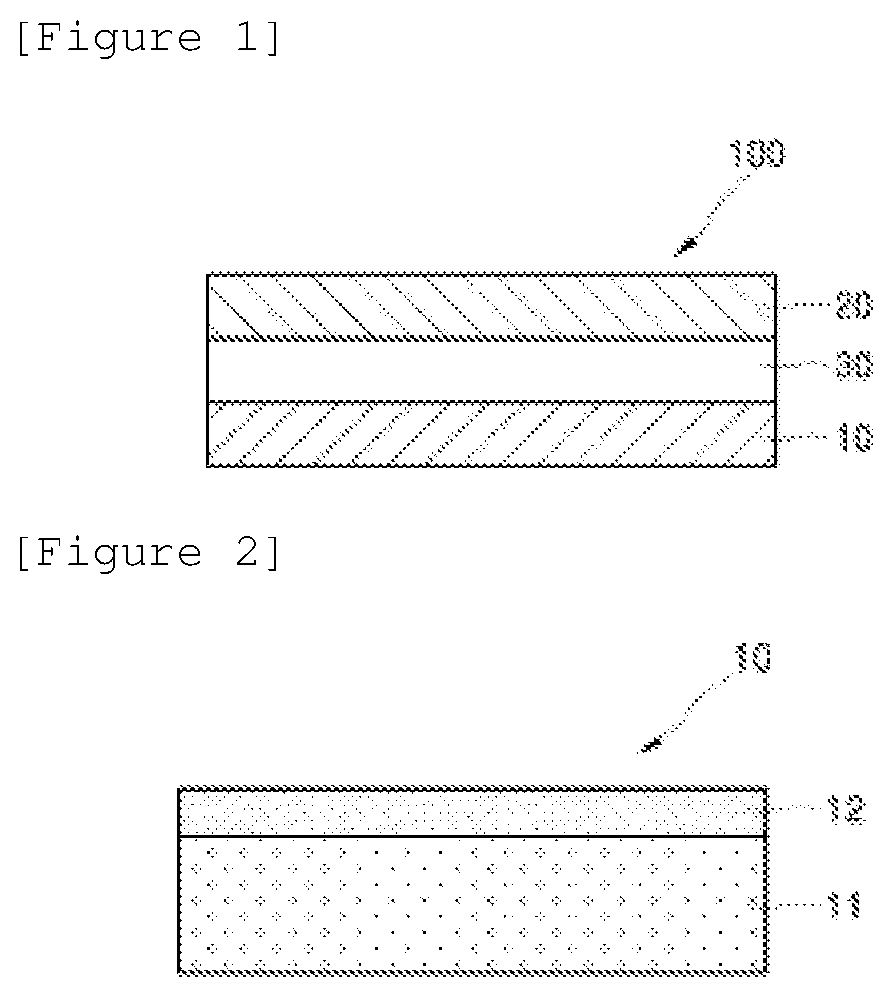Method for measuring peeling stability of release film and release film laminate
a technology of release film and stability, which is applied in the direction of film/foil adhesives, instruments, mechanical means, etc., can solve the problems of adhesive lifting up, and achieve excellent peeling stability among a plurality of release films, high reliability and accuracy, and the effect of ensuring efficiency
- Summary
- Abstract
- Description
- Claims
- Application Information
AI Technical Summary
Benefits of technology
Problems solved by technology
Method used
Image
Examples
example 1
[0055]A laminate including an acrylic adhesive layer and a light-peel release film and a medium-peel release film attached to both sides of the adhesive layer was prepared. The component and content of each release layer and base layer of the light-peel release film and the medium-peel release film are shown in the following Table 1. Subsequently, for the light-peel release film and the medium-peel release film, a light-peel, low-speed release strength (A) and a medium-peel, low-speed release strength (B) were measured by measuring the release strength at the peeling speed of 0.3 m / min. Subsequently, for the same laminate, a light-peel, high-speed release strength (C) and a medium-peel, high-speed release strength (D) were measured by measuring the release strength at the peeling speed of 30 m / min. Subsequently, a low-speed release strength balance and a high-speed release strength balance were measured by calculating the values of B / A and D / C. Furthermore, a light-peel speed change...
example 2
[0057]The component and content of each release layer and base layer of the light-peel release film and the medium-peel release film are shown in the following Table 2, and except for the component and content, the low-speed release strength balance, the high-speed release strength balance, the light-peel speed change rate, and the medium-peel speed change rate were measured in the same manner as in Example 1. The results are shown in the following Table 3.
[0058]
TABLE 2PolydimethylsiloxaneSiliconePt-based(PDMS)resincatalystLight-ReleaseTo 100—5peellayerreleaseBase100 μm PET filmfilmlayerMedium-ReleaseTo 100305peellayerreleaseBase100 μm PET filmfilmlayer
[0059]The low-speed release strength balance, the high-speed release strength balance, the light-peel speed change rate, and the medium-peel speed change rate, which were measured by the method for measuring the peeling stability of a release film in Examples 1 and 2, are shown in the following Table 3.
[0060]
TABLE 3Low-speedHigh-speed...
PUM
| Property | Measurement | Unit |
|---|---|---|
| peeling speed | aaaaa | aaaaa |
| peeling speed | aaaaa | aaaaa |
| peeling speed | aaaaa | aaaaa |
Abstract
Description
Claims
Application Information
 Login to View More
Login to View More - R&D
- Intellectual Property
- Life Sciences
- Materials
- Tech Scout
- Unparalleled Data Quality
- Higher Quality Content
- 60% Fewer Hallucinations
Browse by: Latest US Patents, China's latest patents, Technical Efficacy Thesaurus, Application Domain, Technology Topic, Popular Technical Reports.
© 2025 PatSnap. All rights reserved.Legal|Privacy policy|Modern Slavery Act Transparency Statement|Sitemap|About US| Contact US: help@patsnap.com

